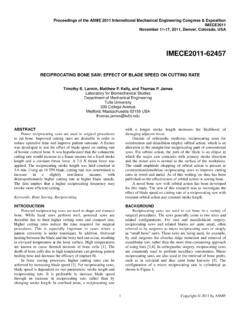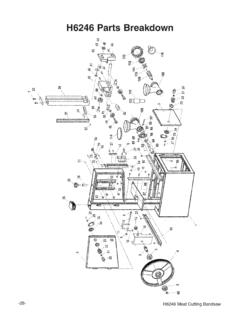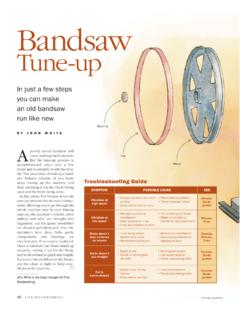Transcription of A Study on the Cutting Rate Performance of a Novel ...
1 A Study ON THE Cutting RATE Performance OF A Novel SAGITTAL BONE SAW Matthew P. Kelly, Timothy B. Lannin, and Thomas P. James Laboratory for Biomechanical Studies Department of Mechanical Engineering Tufts University 200 College Avenue Medford Massachusetts 02155 USA ABSTRACT Conventional sagittal saws have been shown to generate significant heat at the Cutting interface due to high friction and slow Cutting rates . To investigate means of reducing sawing temperatures, a new sagittal sawing mechanism was developed to experiment with Cutting parameters such as blade speed, stroke length, and thrust force. A unique aspect of the new mechanism is the ability to create blade movement in a direction normal to the oscillating motion.
2 This enables the user to generate a thrust force by mechanical means, rather than through the application of a thrust force by hand. For this initial Study , the new mechanism was characterized as a conventional sagittal saw, with Cutting rates measured as a function of blade speed for a constant externally applied thrust force. The relationship between Cutting rate and oscillatory blade speed was not linear in the region tested. At lower blade speeds, the Cutting rate leveled off. As blade speed increased beyond an apparent threshold, Cutting rates increased significantly for a relatively small change in blade speed.
3 Keywords: Bone Sawing, Sagittal INTRODUCTION The aim of this research was to introduce a new sagittal bone sawing mechanism, capable of blade motion perpendicular to the Cutting direction, and to create a baseline Study for the effect of blade speed on the Cutting rate of bovine cortical bone. Conventional sagittal saws used in bone sawing have some areas where design improvements could increase Cutting efficiency and thereby have a positive impact on patient outcomes. First, the continual application of a downward force by a surgeon on a sagittal saw causes significant friction as the saw blade teeth slide across the bone.
4 This friction creates heat in the surrounding bone tissue. High temperatures are known to cause necrosis of bone cells, increasing the time necessary for healing and decreasing the quality of fit for replacement joints [1]. Second, the application of the downward thrust force can create an unsafe condition when the saw blade suddenly breaks through the bone at the end of the cut, potentially causing the surgeon to unintentionally thrust the saw blade into surrounding tissue. Finally, inefficient bone sawing affects the time required for surgical procedures, which is particularly important if the patient is under tourniquet, such as in total knee arthroplasty.
5 The authors have developed a new sagittal sawing mechanism that is conducive to research investigations of sawing parameters that may have an effect on Cutting efficiency. The first of these parameters to be investigated was oscillating speed. It has been shown that the speed at which the blade passes over the bone affects the friction of Cutting [2], so blade speed may affect heat generation and Cutting Performance . BACKGROUND Previous studies have been done on the orthogonal machining of bone, that is, the process of a rigidly-held, single-tooth cutter making a single pass across a rigidly held specimen at a prescribed depth of cut.
6 Jacobs et al. investigated chip formation during orthogonal machining of bone and paid particular attention to the orientation of the osteons with respect to the cutter [3]. Jacobs noted that Cutting depth and rake angle both had a significant effect on the forces during Cutting , and that various combinations produced dramatically different chip structures. Wiggins and Malkin extended upon Jacobs work by considering much larger depths of cut and evaluating parameters based on specific energy instead of force. They found that increasing the depth of cut and increasing the rake Proceedings of the JSME/ASME 2011 International Conference on Materials and Processing ICM&P2011 June 13-17, 2011, Corvallis, Oregon, USA ICMP2011-51073 1 Copyright 2011 by JSME angle (having a sharper-angled tooth wedge) resulted in more efficient Cutting [4].
7 Itoh, et al. [5], Yeager et al. [6], and Sugita and Mitsuishi [7] conducted similar studies. Krause studied the effect of imposing ultrasonic vibrations to reduce the friction at the bone-tool interface and found that it did decrease the energy expenditure of Cutting [2]. Orthogonal machining studies, however, may not completely represent the Cutting conditions of multi-tooth bone sawing blades, in which a relatively constant force is applied, and the Cutting rate is allowed to vary. This reversal of the independent and dependant variables may affect the overall Performance of the device. Furthermore, chip buildup and clogging on a blade with multiple teeth affect real devices, but are neglected in single tooth orthogonal machining studies.
8 Finally, the interactions of multiple teeth may affect Performance . For these reasons, a research device more similar to a conventional surgical sagittal saw than an orthogonal machining tool was developed. SAGITTAL SAWING MECHANISM DESIGN The design of this new sagittal sawing fixture is primarily centered on the dynamics of the blade path and less so on the tool-chip interface. The goal of the fixture design was to provide a platform for research into sawing parameters that may have an effect on Cutting efficiency. A Novel approach has been taken to decouple the Cutting and thrust movement of the blade. One hypothesis driving this design decision was that a high thrust force during a portion of the Cutting path may create a significant depth of cut per saw blade tooth, thereby increasing Cutting rates and sawing efficiency.
9 In present sawing devices, the thrust force is applied as a constant throughout the Cutting path. A constant thrust force creates a constant frictional force. An interrupted thrust force results in a jackhammer-like motion, analogous to percussive drilling of rock [8]. This jackhammer motion of the saw blade may increase Cutting efficiency. In this new sawing mechanism, the frequency of oscillation in the Cutting direction is mechanically coupled to the frequency of oscillation in the thrust direction. It was determined that the thrusting frequency should be an even multiple of the Cutting frequency.
10 This creates Cutting paths that resemble a figure-eight as shown in fig. 1. Uneven multiples of thrust and Cutting frequency produce a blade path that is asymmetric. An asymmetric blade path creates a bias in the Cutting direction of the sagittal saw, causing the blade to pull to one side which reduces control and makes Cutting difficult. This condition was verified with an initial prototype. With this new sawing mechanism, both the amplitude and length of the figure-eight can be varied independently. As the amplitude of the figure-eight approaches zero, the mechanism creates the blade path of a traditional sagittal saw, which is pure oscillatory motion.










